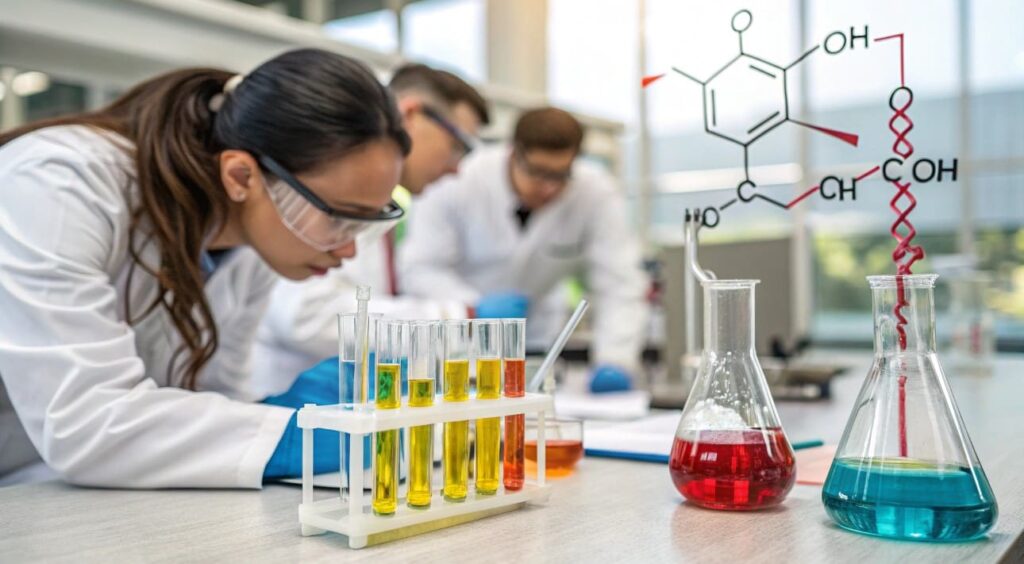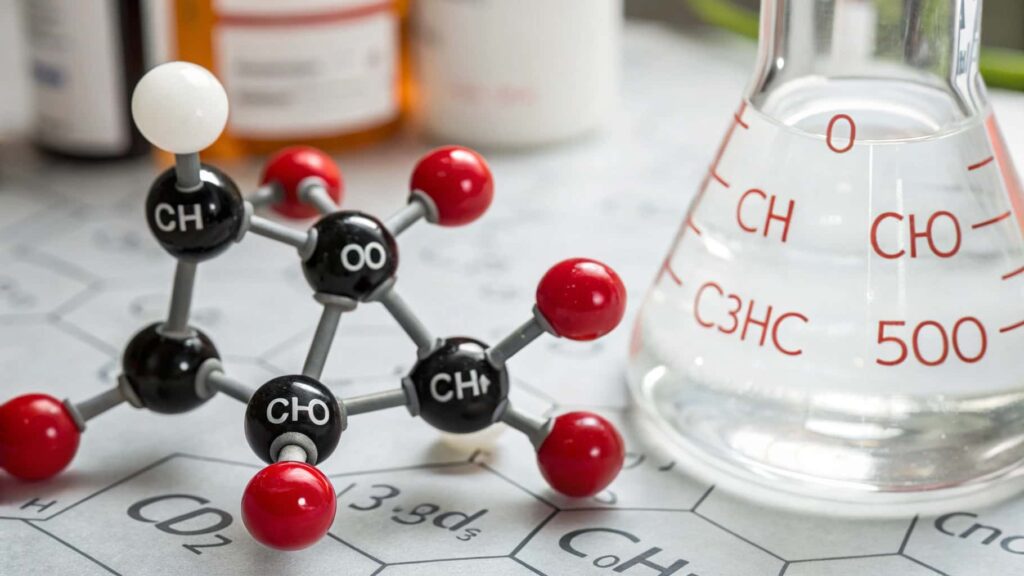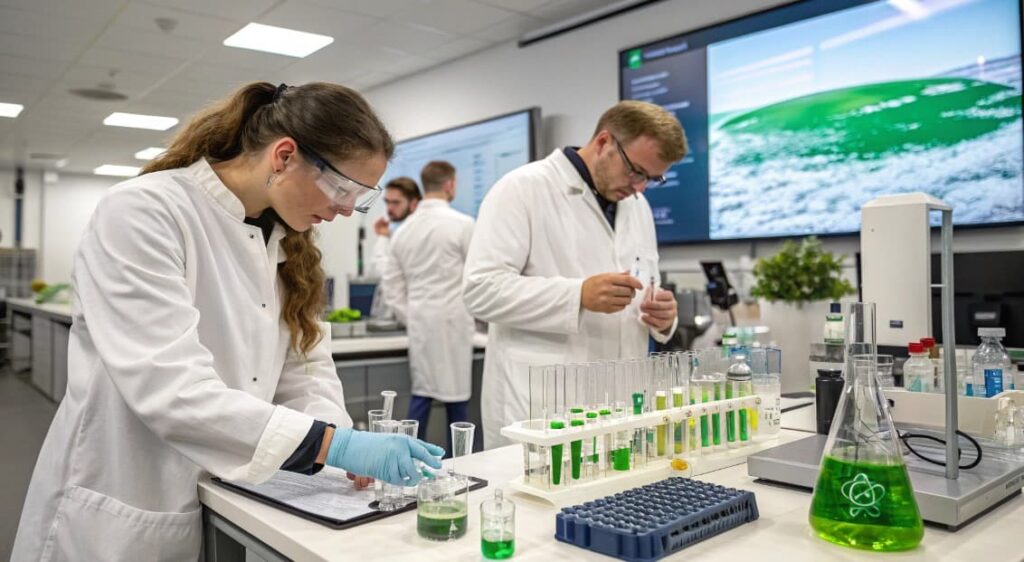When we talk about Hcooch Ch2 H2o, we’re diving into an essential chemical process that plays a critical role both in the laboratory and across various industries. At its core, this phrase represents the hydrolysis of methyl formate — a reaction where methyl formate (HCOOCH₃) reacts with water (H₂O) to produce two vital compounds: formic acid and methanol.
Although it might sound complex, this reaction illustrates fundamental organic chemistry principles and has widespread applications in manufacturing, energy, agriculture, and more. Understanding how this process works, why it’s important, and how it’s applied in real life can open doors to advancements in chemical production and sustainable industrial practices.
In this article, we will explore the detailed chemistry behind Hcooch Ch2 H2o, discuss its mechanism step-by-step, review its industrial significance, and address important safety and environmental considerations. Plus, we’ll answer common questions and provide clear explanations to make the topic accessible.
What Is Hcooch Ch2 H2o?
At first glance, Hcooch Ch2 H2o appears cryptic, but it’s essentially a chemical shorthand focusing on the interaction between methyl formate (HCOOCH₃) and water (H₂O). To decode:

- HCOOCH₃ (Methyl formate) is an ester formed from formic acid and methanol. Esters are organic compounds characterized by a carbonyl group (C=O) bonded to an oxygen atom attached to another carbon atom.
- CH₂ represents a methylene group, the simplest carbon chain segment, often part of larger molecules.
- H₂O (Water) serves as a reactant, breaking the ester bond through hydrolysis.
When combined, the phrase refers to the hydrolysis (water-driven cleavage) of methyl formate into two simpler compounds:
- Formic acid (HCOOH): The simplest carboxylic acid, widely used in various industries.
- Methanol (CH₃OH): The simplest alcohol, crucial in chemical manufacturing and fuel applications.
This reaction is a fundamental example of ester hydrolysis—a process where water molecules attack an ester bond, splitting it into an acid and an alcohol.
Why Study Methyl Formate Hydrolysis?
The hydrolysis of methyl formate is more than just an academic exercise. It’s a key reaction with implications in:
- Foundational Organic Chemistry: This reaction is a classic demonstration of nucleophilic acyl substitution—a key concept in organic synthesis. It helps students and researchers understand how molecules interact, bond cleavage occurs, and catalysts influence reaction rates.
- Industrial Importance: Formic acid and methanol are both industrial heavyweights. Formic acid is employed in leather tanning, textile dyeing, and agriculture, while methanol serves as a feedstock for formaldehyde production, fuels, and solvents. Efficient production methods for these chemicals have wide economic impact.
- Sustainability and Green Chemistry: Hydrolysis uses water, a benign reagent, instead of hazardous chemicals, aligning well with green chemistry principles. Exploring this reaction helps develop cleaner, safer chemical processes.
- Energy Sector Potential: Methanol’s role as a clean fuel alternative and in fuel cells highlights the reaction’s relevance to sustainable energy research.
- Analytical and Practical Applications: Studying this reaction improves catalyst design, reaction condition optimization, and environmental impact assessment.
Studying this reaction helps chemists optimize conditions, improve yields, ensure safety, and innovate for future applications.
How Does The Hydrolysis Of Methyl Formate Work And Why Is It Important?
Understanding the Chemical Reaction:
At its core, the hydrolysis of methyl formate is a simple yet important chemical process. The reaction involves methyl formate (HCOOCH₃) reacting with water (H₂O) to produce two valuable compounds: formic acid (HCOOH) and methanol (CH₃OH). The overall chemical equation can be written as:
HCOOCH3+H2O→HCOOH+CH3OH
In this process, the ester bond within methyl formate is broken by water, resulting in the formation of an acid and an alcohol.
Why Does This Reaction Take Place?
The key to this reaction lies in the nature of the ester bond. The carbon atom in the carbonyl group (C=O) of the ester is electrophilic, meaning it has a partial positive charge and is attracted to nucleophiles — species that donate electrons. Water acts as the nucleophile, attacking this positively charged carbon. This attack weakens the bond between the carbonyl carbon and the methoxy group (-OCH₃), leading to its cleavage and formation of the two products.
Comparing Acidic and Basic Hydrolysis:
The hydrolysis of methyl formate can proceed under two different conditions, each affecting the reaction pathway and products:
- Acidic Hydrolysis: In this pathway, an acid catalyst protonates the oxygen atom of the carbonyl group. This protonation increases the electrophilicity of the carbonyl carbon, making it more vulnerable to nucleophilic attack by water. Acidic hydrolysis is favored in industrial applications because it tends to be faster and produces cleaner products with easier separation.
- Basic Hydrolysis (Saponification): Here, the reaction occurs under basic conditions, producing methanol and the formate ion rather than free formic acid. This formate ion requires subsequent acidification to convert it into formic acid. Due to the additional neutralization step and complexity in product recovery, basic hydrolysis is less preferred industrially.
The Role of the Reaction Environment:
Several factors within the reaction environment can influence the efficiency of methyl formate hydrolysis:
- Excess Water: Having water in abundance pushes the reaction equilibrium toward the formation of formic acid and methanol, according to Le Chatelier’s principle. This helps maximize product yield.
- Catalysts: Acid catalysts, such as sulfuric acid, are often used to speed up the reaction by enhancing the electrophilic character of the carbonyl carbon.
- Temperature: Increasing the temperature provides energy to overcome activation barriers, thereby accelerating the reaction rate. However, temperature control is essential to prevent unwanted side reactions.
Together, these conditions are carefully optimized in industrial settings to ensure efficient, high-yield hydrolysis of methyl formate.
Detailed Reaction Mechanism – How It Really Works!
Understanding the step-by-step mechanism helps explain why catalysts matter and how conditions affect the reaction.

- Protonation of the Ester: Under acidic conditions, an acid donates a proton (H⁺) to the carbonyl oxygen of the ester group in methyl formate. This protonation makes the carbonyl carbon more electrophilic (electron-deficient), so it becomes easier for the water molecule to attack.
- Nucleophilic Attack by Water: The water molecule attacks the electrophilic carbonyl carbon, forming a tetrahedral intermediate — a temporary structure where the carbon atom is bonded to four different atoms/groups.
- Proton Transfer and Bond Cleavage: Within this intermediate, a proton transfers to facilitate breaking the bond between the carbonyl carbon and the methoxy group (-OCH₃). This cleavage releases methanol.
- Deprotonation of Formic Acid: The remaining part of the molecule, protonated formic acid, loses its extra proton to become stable formic acid.
How Factors Affect The Hydrolysis Of Methyl Formate?
Several factors influence how fast and efficiently this reaction occurs:
| Factor | Effect on Reaction | Explanation |
|---|---|---|
| Catalyst Type | Acid catalysts increase rate | Protonate ester, increase electrophilicity |
| Temperature | Moderate heat accelerates, excess causes side reactions | Increases molecular collisions, but too hot destabilizes reactants |
| Water Quantity | Excess drives reaction forward | Le Chatelier’s principle favors product formation |
| Reaction Medium | Acidic preferred for efficiency | Cleaner products, easier separation |
| Removal of Products | Removing methanol pushes equilibrium | Shifts reaction toward completion |
What Are the Key Industrial Applications of the Hcooch Ch2 H2o Reaction?
The hydrolysis of methyl formate, often represented by the formula Hcooch Ch2 H2o in shorthand, plays a pivotal role in several industrial processes due to the valuable products it yields—formic acid and methanol. Understanding these applications sheds light on why this reaction remains a cornerstone in chemical manufacturing.
Formic Acid Production:
One of the primary industrial uses of the Hcooch Ch2 H2o reaction is the large-scale production of formic acid (HCOOH). Formic acid is a versatile chemical with numerous applications, including:
- Leather Tanning and Textile Processing: Formic acid acts as a pH regulator and preservative, helping improve the quality and durability of leather and fabrics.
- Agriculture: It is widely used as a preservative in animal feed and as an antibacterial agent to inhibit microbial growth.
- Chemical Industry: Formic acid serves as an intermediate in the synthesis of various chemicals, such as pharmaceuticals, herbicides, and dyes.
The efficiency and relative simplicity of hydrolyzing methyl formate make this an attractive method for producing high-purity formic acid, especially when catalyzed under acidic conditions.
Methanol Manufacturing:
Methanol (CH₃OH), the other product of the Hcooch Ch2 H2o reaction, is equally valuable and finds extensive use across industries:
- Fuel Industry: Methanol is a key component in the production of biofuels and can be used directly as a clean-burning fuel or fuel additive.
- Chemical Synthesis: It acts as a precursor for formaldehyde, acetic acid, and various plastics and adhesives.
- Renewable Energy: Methanol fuel cells are gaining traction as a sustainable energy source, and methanol is increasingly important in green chemistry initiatives.
The ability to generate methanol and formic acid simultaneously from a single reaction makes the Hcooch Ch2 H2o hydrolysis process highly efficient and cost-effective.
Other Industrial Uses
Beyond the direct production of formic acid and methanol, the hydrolysis reaction also supports:
- Environmental Applications: Formic acid is used in carbon capture processes and other green chemistry solutions aimed at reducing industrial emissions.
- Pharmaceutical Manufacturing: Both methanol and formic acid serve as solvents and reactants in drug synthesis.
- Pesticide Production: Formic acid derivatives are key ingredients in several pesticides and herbicides.
What Safety And Handling Precautions Are Needed For The Hcooch Ch2 H2o Reaction?
The Hcooch Ch2 H2o reaction involves chemicals that require strict safety protocols during handling and storage. Methyl formate is highly flammable and can be toxic when inhaled, while methanol is also flammable and poses significant health risks if ingested or absorbed through the skin. Formic acid, a product of this reaction, is corrosive and can cause severe burns or respiratory irritation.
Proper use of personal protective equipment (PPE)—including gloves, goggles, and lab coats—is essential, along with ensuring adequate ventilation or fume hoods in work areas. Emergency procedures, chemical spill kits, and material safety data sheets (MSDS) should always be readily accessible in any facility conducting this reaction.
The Environmental Implications Of The Hcooch Ch2 H2o Reaction – Need To Know!
Because water is the main reagent in the Hcooch Ch2 H2o reaction, it supports green chemistry goals by reducing the use of harmful solvents. The resulting products—formic acid and methanol—are biodegradable and generally less harmful to the environment than many synthetic chemicals. However, both methanol and formic acid are toxic in higher concentrations, so proper disposal and emissions control are crucial.
If not handled correctly, methanol can contaminate water sources, and formic acid can cause damage to ecosystems. Industrial facilities must ensure that waste is treated before disposal and that air emissions are filtered to reduce potential harm. Using closed systems and recycling unused materials can further reduce the environmental footprint of this reaction.
How Does the Hcooch Ch2 H2o Reaction Help Students Learn Organic Chemistry?
For chemistry students, methyl formate hydrolysis is an excellent case study to understand:
- Illustrates Ester Hydrolysis: Demonstrates a key organic reaction involving the breakdown of esters into acids and alcohols.
- Teaches Reaction Mechanisms: Helps students understand step-by-step acid/base catalyzed reaction pathways.
- Reinforces Nucleophilic Substitution: Shows how nucleophiles (like water) attack electrophilic centers in organic molecules.
- Connects Theory to Real-World Use: Links classroom learning to industrial and environmental applications.
- Encourages Critical Thinking: Students learn to analyze how conditions (pH, temperature, catalysts) affect reaction outcomes.
- Supports Green Chemistry Concepts: Offers a practical example of sustainable chemistry practices using water as a reagent.
It’s widely used in academic labs for teaching practical organic chemistry skills.
Exploring Advanced Perspectives And Future Directions – Dont Miss Out!

Green and Sustainable Chemistry:
Researchers are looking at:
- Using milder acids or solid acid catalysts to reduce waste.
- Catalysts that enable the reaction at room temperature to save energy.
- Integration into biomass conversion processes to produce bio-based formic acid and methanol.
Space and Astrochemistry:
Interestingly, methyl formate has been detected in interstellar clouds, hinting at chemical processes that might contribute to the origins of life or planetary chemistry
FAQs:
How does acid catalysis affect the reaction?
Acid catalysts such as sulfuric acid protonate the ester group, making it more reactive. This increases the speed of hydrolysis and improves the overall yield. Acidic conditions are preferred in industrial setups for their efficiency.
Can the Hcooch Ch2 H2o reaction occur under basic conditions?
Yes, the reaction can also take place in a basic environment, known as saponification. It leads to the formation of methanol and the formate ion, which may later be acidified. However, basic hydrolysis is less favored due to extra processing steps
Is the reaction environmentally friendly?
Yes, to a degree—it uses water as a reagent, aligning with green chemistry practices. However, proper handling is required due to the toxicity of the products. Environmental impact can be minimized with responsible waste management and emissions control.
How does temperature affect the reaction rate?
Higher temperatures accelerate the reaction by increasing molecular motion and collision frequency. However, excessive heat may lead to unwanted side reactions or evaporation of volatile components. Temperature control is key for maintaining product purity.
How are the products separated after the reaction?
After completion, methanol and formic acid can be separated through distillation or extraction techniques. Their different boiling points make this process straightforward. Proper separation ensures high purity for further industrial or lab use.
Can this reaction be scaled for commercial production?
Yes, the Hcooch Ch2 H2o reaction is scalable and widely used in industrial settings. Its simplicity, cost-effectiveness, and efficiency make it suitable for large-scale chemical synthesis. With proper controls, it delivers consistent, high-quality results.
Conclusion:
The Hcooch Ch2 H2o reaction is more than just a chemical process—it’s a key part of how we create useful substances like formic acid and methanol. This reaction helps students learn core concepts in organic chemistry while also powering real-world industries. Its use of water makes it a cleaner, greener option compared to other methods.
With the right conditions and safety measures, it can be both efficient and environmentally responsible. Whether in a lab or factory, understanding this reaction opens doors to deeper scientific knowledge. It’s a perfect example of how chemistry connects learning, innovation, and practical solutions.
Also Read:








Leave a Reply